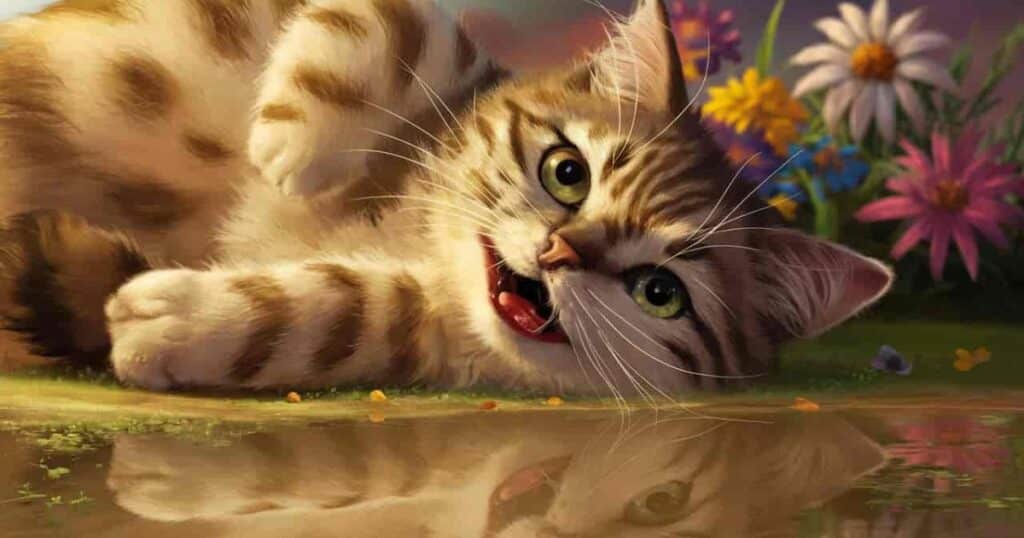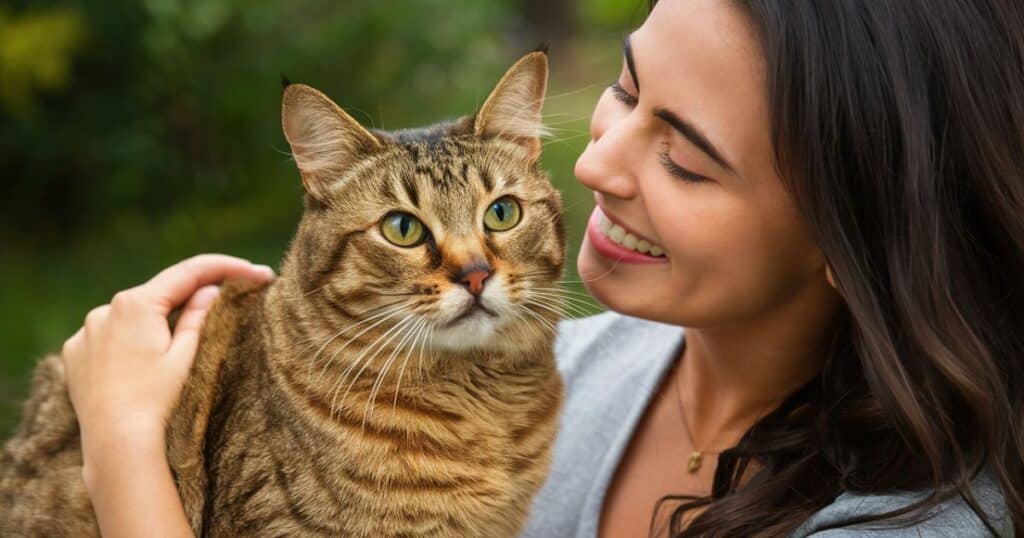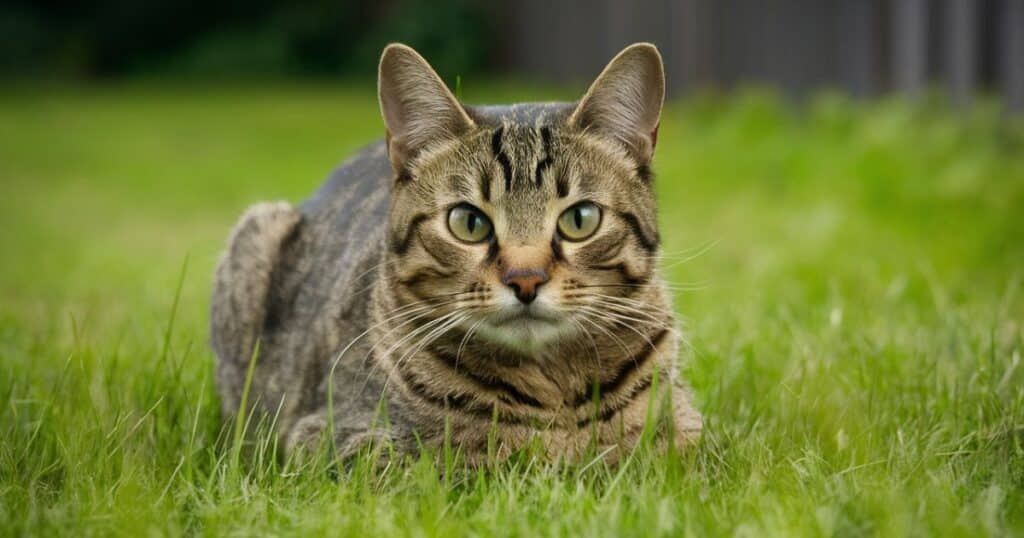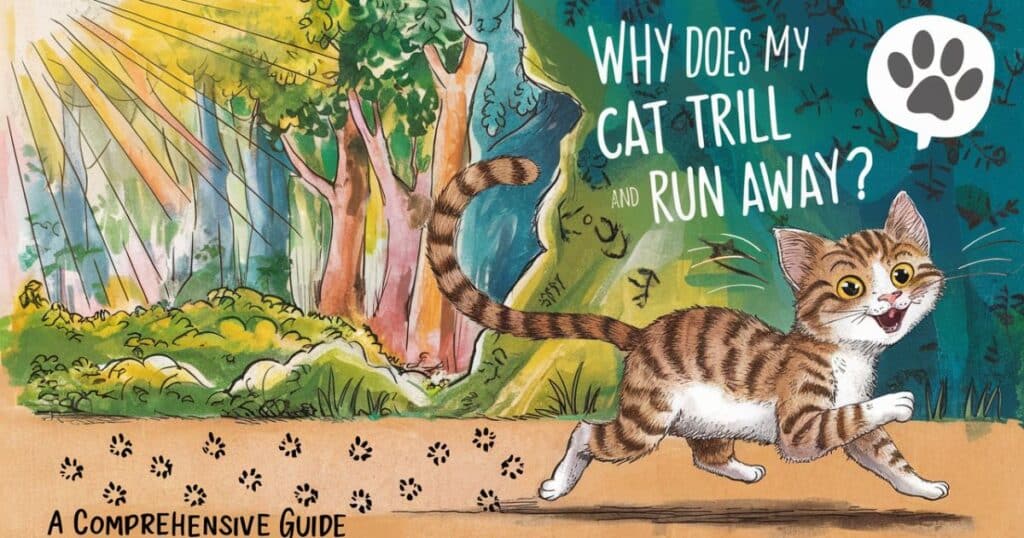Have you ever found yourself in a peculiar dance with your feline friend? One moment, they’re trilling sweetly, and the next, they’re dashing off like a furry bolt of lightning. If you’re nodding in agreement, you’re not alone in this mystifying world of cat behavior.But fear not! We’re about to embark on a journey to unravel the secrets behind the question: “Why does my cat trill and run away?”
Cats, with their enigmatic ways, have been captivating humans for thousands of years. From ancient Egypt to modern-day living rooms, these graceful creatures continue to intrigue us with their complex personalities and behaviors. Trilling, a unique vocalization that’s part meow, part purr, is just one of the many ways cats communicate with us and their environment.
In this comprehensive guide, we’ll explore the ins and outs of cat trilling, delve into the reasons behind their swift exits, and provide you with insights to better understand and bond with your feline companion. Whether you’re a seasoned cat parent or new to the world of whiskers and purrs, this article will equip you with the knowledge to decode your cat’s language and strengthen your furry friendship.
So, let’s dive in and discover why your cat might be serenading you with trills before making a hasty retreat. Get ready to become a feline behavior detective and unlock the mysteries of your cat’s quirky conduct.
What Do Trills Sound Like?
Before we dive deeper into the reasons behind your cat’s trilling and running, let’s take a moment to appreciate the unique sound of a trill. If you’ve never heard a cat trill before, you’re in for a treat.
A cat’s trill is a distinctive vocalization that combines elements of a meow and a purr. It’s often described as a high-pitched, chirpy sound that rolls off the tongue. Imagine a soft “prrrrup” or “brrrrp” that seems to vibrate in your cat’s throat. This melodic sound is quite different from other cat vocalizations, which makes it all the more intriguing.
To better understand trills, let’s compare them to other common cat sounds:
| Vocalization | Description | Purpose |
| Meow | A classic “miaow” sound, varying in pitch and length | General communication, often directed at humans |
| Purr | A low, rumbling sound made during inhalation and exhalation | Contentment, self-soothing, or seeking attention |
| Hiss | A sharp, drawn-out “sssss” sound | Warning or defensive signal |
| Growl | A low, guttural sound | Aggression or serious warning |
| Chirp | A short, high-pitched “chirrup” or “ekekek” sound | Often used when spotting prey or in excitement |
| Trill | A rolling “prrrrup” that combines a meow and purr | Friendly greeting, attention-seeking, or “follow me” signal |
As you can see, trills stand out from the feline vocal repertoire. They’re often described as more musical and pleasant to the human ear compared to other cat sounds. In fact, many cat owners find trills to be one of the most endearing vocalizations their pets make.
Fun fact: Did you know that trills are sometimes called “chirps” or “chirrup” sounds? This is because they can resemble the sounds made by birds, which might be linked to a cat’s predatory instincts. However, when directed at humans or other cats, trills are generally considered friendly vocalizations.
It’s worth noting that not all cats trill with the same frequency or in the same situations. Some cats are more vocal than others, and individual personalities play a significant role in how often a cat might trill. Additionally, certain breeds, such as Siamese and Maine Coons, are known for being more talkative and may trill more frequently than others.
Now that we’ve familiarized ourselves with the unique sound of a cat’s trill, let’s explore the reasons behind this charming vocalization and why it’s often followed by a swift exit.
MORE POST: How Long Can A Cat Go Without Peeing? A Comprehensive Guide For Cat Owners
Why Do Cats Trill?

Trilling is a fascinating aspect of feline communication, and understanding its purpose can provide valuable insights into your cat’s mindset. While every cat is unique, there are several common reasons why cats trill. Let’s explore these motivations in detail:
1. They want you to come along
One of the primary reasons cats trill is to encourage you to follow them. It’s their way of saying, “Hey, human! Come check this out.” This behavior is deeply rooted in feline social structures and has its origins in mother-kitten interactions.
In the wild, mother cats use trills to guide their kittens and keep the litter together. As kittens grow and begin to explore their surroundings, the mother’s trills serve as a gentle encouragement to follow her lead. This behavior is often observed when a mother cat is moving her kittens to a new den or guiding them to a food source.
Domesticated cats have adapted this behavior to communicate with their human family members. Your cat might trill and walk away, periodically looking back to ensure you’re following. This could lead to various destinations:
- Food bowl: Your cat may be telling you it’s mealtime or that the food bowl needs a refill.
- Toys: They might want to show you a favorite toy or initiate playtime.
- Doors or windows: Your cat could be alerting you to something interesting outside or requesting to go out (for indoor-outdoor cats).
- Cozy spots: Sometimes, they just want to share a comfortable napping spot with you.
By responding to your cat’s trills and following them, you’re reinforcing the bond between you and acknowledging their attempt to communicate.
2. They’re just saying hello
Trilling often serves as a friendly greeting in the feline world. When your cat trills at you, it’s their way of saying, “Hi there! I’m happy to see you.” This vocalization is generally considered a positive, welcoming sound that indicates your cat is in a good mood and feeling social.
The use of trills as a greeting has its roots in early kittenhood. Mother cats trill to their kittens as a form of reassurance and acknowledgment. Kittens learn to associate this sound with positive interactions and carry this behavior into adulthood.
When your adult cat greets you with a trill, they’re essentially treating you as a member of their feline family. It’s a sign of affection and trust. You might notice your cat trilling when:
- You return home after being away
- You enter a room where they’re resting
- They approach you for attention or petting
Some cats may even trill in response to your voice or movements, creating a sort of conversation between you and your feline friend.
3. It’s a demand for attention
Cats are masters of communication, and trilling is one of the tools in their vocal arsenal for grabbing your attention. When your cat wants something from you, they may use a trill as a polite yet insistent way to make their desires known.
Trilling for attention can be distinguished from other attention-seeking vocalizations, such as meowing, in a few ways:
- Tone: Trills tend to have a more pleasant, musical quality compared to meows, which can sometimes sound demanding or plaintive.
- Duration: Trills are usually shorter than prolonged meows, making them a more subtle form of communication.
- Context: While meows are often used for various requests (like food or going outside), trills are more commonly associated with social interaction and companionship.
Your cat might trill for attention when they:
- Want to be petted or cuddled
- Are inviting you to play
- Feel lonely or bored
- Are trying to guide you to something they find interesting
It’s important to note that excessive trilling or changes in your cat’s vocal patterns could indicate underlying issues, such as stress, anxiety, or health problems. If you notice a significant increase in trilling or other unusual behaviors, it’s best to consult with your veterinarian.
Understanding these common reasons for trilling can help you better interpret your cat’s needs and strengthen your bond. However, the mystery deepens when we consider why cats often run away after trilling. To unravel this puzzle, we need to delve deeper into feline behavior and psychology.
Cat Behavior: The Basics
To truly understand why your cat trills and runs away, it’s essential to have a grasp on the basics of feline behavior. Cats are complex creatures with a rich history of domestication that has shaped their interactions with humans. Let’s explore some fundamental aspects of cat behavior that will provide context for their trilling and running antics.
Feline Communication Methods
Cats are masters of non-verbal communication, using a variety of methods to express themselves:
- Vocalizations: Beyond trills, cats use meows, purrs, hisses, and growls to convey different messages.
- Body Language: Tail positions, ear movements, and facial expressions all play crucial roles in feline communication.
- Scent Marking: Cats use pheromones from glands in their cheeks, paws, and other areas to mark territory and communicate with other cats.
- Tactile Communication: Rubbing against objects or people, kneading, and grooming are forms of physical communication.
Understanding these various methods helps us appreciate the complexity of cat communication and the importance of observing our feline friends holistically.
The Impact of Domestication
The domestication of cats, which began around 10,000 years ago, has significantly influenced their behavior and communication with humans. Unlike dogs, which were actively domesticated for specific purposes, cats largely self-domesticated by adapting to human settlements for food and shelter.
This unique history means that cats have retained many of their wild instincts while developing behaviors specifically for interacting with humans. For example:
- Meowing is more common in domesticated cats and is primarily used for human-cat communication.
- Domesticated cats have adapted their natural hunting behaviors into play, using toys as substitutes for prey.
- The trill, while rooted in mother-kitten communication, has evolved to become a social vocalization directed at humans.
The Importance of Body Language
While vocalizations like trills are important, a cat’s body language often provides more nuanced information about their mood and intentions. Key elements of feline body language include:
- Tail Positions: A raised tail with a slight curve at the tip often indicates a friendly greeting, while a puffed-up tail signals fear or aggression.
- Ear Movements: Forward-facing ears suggest curiosity or contentment, while flattened ears indicate fear or aggression.
- Eye Contact: Slow blinks are a sign of trust and affection, often referred to as “cat kisses.”
- Overall Posture: A relaxed, loose posture indicates comfort, while a tense, crouched position may signal fear or readiness to pounce.
When interpreting your cat’s trilling and running behavior, it’s crucial to consider these body language cues alongside the vocalization.
The Role of Instinct
Despite thousands of years of domestication, cats retain many instincts from their wild ancestors. These instincts continue to influence their behavior in domestic settings:
- Hunting Instincts: Even well-fed house cats may exhibit stalking, pouncing, and chasing behaviors.
- Territorial Nature: Cats are naturally inclined to establish and defend their territory.
- Predator and Prey Mindset: Cats can quickly switch between feeling like a predator (confident and playful) to feeling like prey (cautious and ready to flee).
- Social Structure: While often seen as solitary, cats have complex social structures that influence their interactions with humans and other cats.
These instincts play a significant role in behaviors like trilling and running away, as we’ll explore in the next section.
By understanding these basic elements of cat behavior, we can better contextualize the quirky combination of trilling and running. Now, let’s dive into the specific reasons why your cat might engage in this intriguing behavior.
Possible Reasons for Trilling and Running Away
Now that we’ve explored the basics of cat behavior and the reasons behind trilling, it’s time to unravel the mystery of why your cat might trill and then suddenly dash off. This behavior, while perplexing, often has logical explanations rooted in feline psychology and instincts. Let’s examine some possible reasons:
1. Playtime Invitation: “Catch Me If You Can!”

One of the most common reasons for the trill-and-run behavior is a playful invitation. Your cat might be initiating a game of chase, tapping into their natural hunting and play instincts. Here’s how this scenario typically unfolds:
- Your cat approaches and trills to get your attention.
- They make eye contact to ensure you’re engaged.
- Suddenly, they dart away, often looking back to see if you’re following.
- If you move towards them, they may continue the game, running and hiding.
This behavior mimics the way cats play with each other and hunt prey in the wild. By trilling and running, your cat is essentially saying, “Hey, let’s play, Try to catch me.”
Case Study: Sarah, a cat owner from Boston, shares her experience: “My tabby, Milo, does this every evening. He’ll trill at me while I’m watching TV, then zoom off down the hallway. If I get up and follow him, he leads me on a merry chase around the house. It’s become our nightly routine, and I think it’s his way of making sure I get some exercise too.”
2. Overstimulation or Excitement
Cats can become overstimulated by various stimuli, including affection from their owners. When a cat becomes too excited, they might trill and run as a way to release that energy or to create some space. Signs of overstimulation include:
- Tail twitching or lashing
- Dilated pupils
- Ears flicking back and forth
- Skin rippling along the back
In these cases, the trill might be an expression of their heightened state, while the running away is a means of self-regulation.
3. Seeking Privacy After Social Interaction
Cats are known for their independent nature, and sometimes they need alone time after social interactions. The trill-and-run behavior might be your cat’s way of politely excusing themselves after a friendly greeting. It’s like they’re saying, “Nice to see you, but I need some me-time now.”
This behavior is particularly common in multi-cat households or homes with a lot of activity. Your cat might seek out a quiet spot to relax or observe their surroundings from a distance.
4. Instinctual Prey Behavior
The combination of trilling and running can sometimes be linked to a cat’s predatory instincts. In the wild, cats use various vocalizations during hunting, including chirps and trills. Your domestic cat might be acting out a hunting scenario:
- They spot something interesting (a toy, a shadow, or even an imaginary prey).
- They trill in excitement or as part of their hunting vocalization.
- They dash off to “chase” or “capture” their target.
This behavior is a healthy expression of their natural instincts and can be encouraged through interactive play sessions with appropriate toys.
5. Anxiety or Fear Response
In some cases, trilling followed by running away might indicate anxiety or a fear response. If your cat is feeling uneasy about something in their environment, they might trill as a way of self-soothing or seeking reassurance, then run to a place they feel safe. Potential triggers could include:
- Sudden noises or movements
- Unfamiliar people or animals
- Changes in the home environment
If you suspect anxiety is the cause, observe your cat’s body language for signs of stress, such as flattened ears, a low tail, or a crouched posture.
Understanding the Context
To determine why your cat is trilling and running away, it’s crucial to consider the context:
- Time of day: Is it around their usual playtime or mealtime?
- Recent changes: Have there been any alterations to their routine or environment?
- Your cat’s overall mood: Do they seem playful, anxious, or somewhere in between?
- Frequency: Is this a regular occurrence or a new behavior?
By observing patterns and considering these factors, you can better understand your cat’s motivations and respond appropriately.
Expert Tip: Dr. Emily Carter, a feline behaviorist, advises, “Pay attention to the subtle cues in your cat’s body language before and after they trill and run. Are their ears forward and tail up, indicating playfulness? Or are they tense and wide-eyed, suggesting anxiety? These details can help you discern between a playful invitation and a stress response.”
Understanding the reasons behind your cat’s trill-and-run behavior is key to strengthening your bond and ensuring their well-being. In the next section, we’ll delve deeper into feline body language to help you become an expert in reading your cat’s cues.
Understanding Feline Body Language
Decoding your cat’s body language is crucial for understanding their trilling and running behavior. While vocalizations like trills provide important auditory cues, a cat’s physical posture and movements offer a wealth of information about their emotional state and intentions. Let’s explore the key elements of feline body language:
Tail Positions and What They Mean
A cat’s tail is like a furry flag, signaling their mood and intentions. Here’s a quick guide to common tail positions:
- Upright with a slight curve or hook: This is a friendly greeting, often seen when your cat approaches you. It’s like a feline “hello” and may accompany a trill.
- Straight up and quivering: Extreme happiness or excitement. Your cat might do this when you come home or during playtime.
- Low and swishing: Indicates focus or mild irritation. If your cat trills and runs with this tail position, they might be in hunting mode.
- Puffed up: Fear or aggression. This makes the cat appear larger to potential threats.
- Wrapped around another cat or person: A sign of affection and bonding.
Pro Tip: If your cat trills and runs with their tail straight up, they’re likely inviting you to follow in a friendly manner.
Ear Movements and Their Significance
Cat ears are incredibly expressive and can rotate 180 degrees. Here’s what different ear positions may indicate:
- Forward-facing: Alert, interested, or content. This is a good sign if seen with trilling.
- Sideways or “airplane ears”: Mild irritation or uncertainty. Your cat might be overstimulated.
- Flattened against the head: Fear or aggression. If your cat trills and runs with flattened ears, they might be anxious.
- One ear forward, one back: Indecision. Your cat is assessing the situation.
Facial Expressions: Squinting, Slow Blinks, and More
A cat’s face can reveal a lot about their mood:
- Slow blinks: Often called “cat kisses,” these indicate trust and contentment.
- Wide eyes with dilated pupils: Excitement or fear, depending on the context.
- Squinting or half-closed eyes: Relaxation and trust. A trilling cat with squinty eyes is likely feeling affectionate.
- Whiskers forward: Curiosity or alertness.
- Licking lips (when no food is present): Possible anxiety or nausea.
How Body Language Complements Trilling Behavior
When interpreting your cat’s trill-and-run behavior, consider their overall body language:
- Relaxed posture with forward ears and an upright tail: Your cat is likely feeling friendly and playful. The trill-and-run could be an invitation to interact.
- Tense body with flattened ears and a low tail: This might indicate anxiety. The trill could be a self-soothing behavior, and the running is an escape.
- Crouched posture with focus and a swishing tail: Your cat might be in “hunting mode,” treating the trill-and-run as part of a predatory game.
Case Study: Lisa from San Diego shares, “My cat Socks used to trill and run away, and I thought he was upset. But I noticed his tail was always up, and he’d look back at me. A feline behaviorist helped me realize he was trying to get me to play chase.”
Understanding these nuances in feline body language can significantly improve your ability to respond appropriately to your cat’s trilling and running behavior. In the next section, we’ll explore how human-cat interactions influence this behavior and how you can build stronger bonds with your feline friend.
Human-Cat Interactions

The way we interact with our cats plays a crucial role in shaping their behavior, including the intriguing trill-and-run phenomenon. By understanding how our responses affect our feline friends, we can create a more harmonious relationship and potentially influence their vocalizations and movements. Let’s delve into the dynamics of human-cat interactions:
How Our Responses Shape Cat Behavior
Cats are astute observers and quick learners. They pick up on patterns in our behavior and adjust their own accordingly. Here’s how our responses can shape their trilling and running behavior:
- Reinforcement: If we consistently respond to trilling by following or playing, cats learn that this behavior effectively gets our attention.
- Ignoring: Conversely, if we regularly ignore trilling, cats may either increase the behavior to get a response or eventually decrease it.
- Inconsistent responses: This can lead to confusion and potentially increase the frequency of the behavior as the cat tries to figure out what works.
- Negative reactions: Scolding or showing frustration might cause anxiety, leading to more erratic behavior or avoidance.
Expert Insight: Dr. Sarah Thompson, a veterinary behaviorist, notes, “Consistency is key in feline behavior modification. If you want to encourage or discourage certain behaviors, your responses should be predictable and aligned with your goals.”
The Role of Positive Reinforcement
Positive reinforcement is a powerful tool in shaping cat behavior. Here’s how you can use it effectively:
- Reward desired behaviors: If you enjoy your cat’s trills, respond with attention, play, or treats when they vocalize without running away.
- Timing is crucial: Rewards should be given immediately after the desired behavior for the cat to make the connection.
- Use various rewards: Some cats prefer physical affection, while others might respond better to treats or playtime. Find what motivates your cat.
- Be patient: Behavior changes take time. Consistent positive reinforcement over weeks or months can yield significant results.
Creating a Safe and Stimulating Environment
A cat’s environment significantly influences their behavior. Here are some tips for creating a cat-friendly space that may reduce excessive trilling and running:
- Provide vertical space: Cat trees, shelves, and perches allow cats to observe their territory and feel secure.
- Offer hiding spots: Boxes, cat caves, or cozy nooks give cats places to retreat when they need alone time.
- Regular playtime: Interactive toys like wand teasers can satisfy hunting instincts and reduce restlessness.
- Puzzle feeders: These engage your cat’s mind and provide a constructive outlet for energy.
- Window views: Perches near windows offer entertainment and can reduce boredom-related behaviors.
Tips for Building Trust with a Trilling, Runaway Cat
If your cat frequently trills and runs away, building trust is essential. Try these approaches:
- Respect their space: Don’t force interactions. Let your cat come to you.
- Use food as a bonding tool: Offer treats or meals while sitting nearby, gradually decreasing the distance over time.
- Engage in interactive play: Use toys that allow you to play together without direct physical contact.
- Speak softly: Use a calm, gentle voice when addressing your cat.
- Create positive associations: Pair your presence with good things like treats or gentle petting.
- Be predictable: Maintain a consistent routine to help your cat feel secure.
Case Study: Tom from Chicago shares his experience: “My rescue cat, Luna, used to trill and dash off constantly. I started sitting on the floor with treats, just talking softly to her. Over a few weeks, she began to stay longer after trilling. Now, she often trills and comes for cuddles instead of running!”
The Impact of Stress on Cat Behavior
Stress can significantly affect a cat’s vocalizations and movement patterns. Common stressors include:
- Changes in routine or environment
- New pets or family members
- Loud noises or unfamiliar sounds
- Health issues or pain
If your cat’s trilling and running behavior seems linked to stress, consider these steps:
- Identify and mitigate stressors: If possible, remove or reduce the source of stress.
- Provide safe spaces: Ensure your cat has quiet areas to retreat.
- Consider pheromone products: Synthetic feline pheromones can help create a calming environment.
- Consult a veterinarian: Rule out medical causes and discuss potential anti-anxiety treatments if needed.
By understanding and adapting our interactions, we can create an environment that fosters positive behavior and strengthens the human-cat bond. In the next section, we’ll explore how environmental factors beyond our direct control can influence our cats’ trilling and running tendencies.
Observing Environmental Factors
The environment in which your cat lives plays a significant role in shaping their behavior, including their tendency to trill and run away. Cats are highly sensitive to their surroundings, and changes in the environment can trigger various responses. Let’s explore the environmental factors that might influence your cat’s vocalizations and movements:
Changes in the Home That Might Trigger Trilling and Running
Cats thrive on routine and familiarity. Any alterations to their environment can cause stress or excitement, potentially leading to increased trilling and running behavior. Common changes include:
- Rearranging furniture: This can disrupt your cat’s established territories and pathways.
- Home renovations: Noise, new smells, and the presence of strangers can be unsettling.
- Moving to a new home: A completely new environment can be overwhelming and may increase anxious behaviors.
- Changes in work schedule: If you’re suddenly home more (or less), it can affect your cat’s routine.
- New objects or appliances: Unfamiliar items can be intriguing or frightening to cats.
Pro Tip: When making changes to your home, try to do so gradually. Provide your cat with a “safe room” that remains unchanged during transitions.
The Impact of New Pets or Family Members
Introducing new animals or people to the household can significantly affect your cat’s behavior:
- New pets: Whether it’s another cat, a dog, or a smaller pet, your cat may feel territorial or anxious.
- Babies or children: The sounds and unpredictable movements of young children can be stressful for cats.
- New roommates or partners: Unfamiliar people in the home can make cats feel insecure.
In these situations, your cat might use trilling as a way to seek reassurance or attention from you, followed by running to a safe space.
Case Study: Emma from Seattle shares, “When we brought our new baby home, our cat Milo started trilling more and would run to hide under the bed. We created a ‘Milo zone’ in the spare room with his favorite toys and bed. Gradually, he became more comfortable and now trills to greet the baby.”
Outside Stimuli: Birds, Squirrels, or Other Cats
Cats are natural predators, and outdoor stimuli can trigger their hunting instincts:
- Birds and small animals: The sight or sound of potential prey can excite your cat, leading to trilling and running behavior.
- Neighborhood cats: Seeing other cats in their territory (even through a window) can cause agitation.
- Outdoor sounds: Traffic, construction, or other urban noises might startle your cat.
- Weather changes: Some cats become more active during certain weather conditions, like before a storm.
To manage these stimuli:
- Provide window perches for safe “outdoor” viewing.
- Use curtains or blinds to limit visual access if it causes stress.
- Create background noise with soft music or a white noise machine to mask outdoor sounds.
Seasonal Changes and Their Effect on Cat Behavior
The changing seasons can influence your cat’s behavior in several ways:
- Daylight changes: Cats are crepuscular, meaning they’re most active at dawn and dusk. Seasonal shifts in daylight can affect their activity patterns.
- Temperature fluctuations: Cats may become more active in cooler weather and more lethargic in extreme heat.
- Hormonal changes: Unaltered cats may exhibit increased vocalization and restlessness during mating seasons (typically spring and fall).
- Seasonal allergies: Just like humans, cats can suffer from allergies that may cause discomfort and behavioral changes.
Expert Insight: Dr. Lisa Chen, a feline specialist, explains, “Seasonal changes can significantly impact a cat’s behavior. For example, the increased bird activity in spring might lead to more excited trilling and running as cats respond to these stimulating sights and sounds.”
Creating an Enriching Indoor Environment
To help manage environmentally triggered trilling and running, consider these enrichment strategies:
- Rotate toys: Regularly introduce new toys and remove others to keep the environment novel and engaging.
- Create exploration opportunities: Cardboard boxes, paper bags, and tunnels provide safe spaces for investigation.
- Use scent enrichment: Cat-safe herbs like catnip or silver vine can provide sensory stimulation.
- Establish feeding routines: Regular meal times can help structure your cat’s day and reduce anxiety.
- Provide scratching outlets: Various scratching posts and pads allow natural marking behaviors.
Monitoring and Adapting to Environmental Changes
Keep a journal of your cat’s behavior in relation to environmental factors. Note any correlations between changes in the environment and increases in trilling and running. This can help you:
- Identify triggers for the behavior.
- Anticipate and prepare for situations that might cause stress.
- Develop strategies to help your cat feel secure during changes.
Remember, every cat is unique. What causes one cat to trill and run might have no effect on another. Observation and patience are key to understanding your individual cat’s responses to their environment.
By being aware of these environmental factors and taking steps to create a stable, enriching space for your cat, you can help manage their trilling and running behavior. However, it’s also important to be alert to any sudden changes in behavior that might indicate health concerns, which we’ll explore in the next section.
Health Concerns: When to Worry
While trilling and running are often normal behaviors, sudden changes or extreme patterns can sometimes indicate underlying health issues. As a responsible cat owner, it’s crucial to be aware of when these behaviors might signal a need for veterinary attention. Let’s explore some health-related concerns that could be linked to excessive trilling or changes in your cat’s running patterns.
Excessive Trilling or Changes in Vocalization Patterns
Cats are creatures of habit, and significant changes in their vocal behaviors can be a red flag. Here are some situations that warrant attention:
- Increased frequency: If your cat suddenly starts trilling much more often than usual, it could indicate discomfort or distress.
- Changes in tone: A trill that sounds different from your cat’s normal vocalization might suggest pain or respiratory issues.
- Trilling at unusual times: For example, if your cat starts trilling excessively at night when they’re usually quiet.
- Combination with other vocalizations: Trilling accompanied by yowling, excessive meowing, or growling could signal distress.
Expert Insight: Dr. Mark Roberts, a veterinary behaviorist, advises, “Any abrupt change in a cat’s vocalization patterns should be taken seriously. It’s their way of communicating that something isn’t right.”
Signs of Pain or Discomfort Accompanying Trilling
Trilling itself isn’t typically associated with pain, but if it’s accompanied by other signs of discomfort, it’s time to pay attention:
- Limping or difficulty moving: This could indicate joint pain or injury.
- Changes in litter box habits: Urinary tract infections or kidney issues can cause discomfort and increased vocalization.
- Loss of appetite: Many health issues can lead to decreased interest in food.
- Excessive grooming or scratching: This might indicate skin irritations or allergies.
- Aggression or irritability: Pain can cause changes in temperament.
Behavioral Changes That Might Indicate Underlying Health Issues

Sometimes, the running part of the trill-and-run behavior can be more telling than the trill itself. Watch for these changes:
- Reluctance to jump or climb: This could suggest arthritis or other joint problems.
- Uncoordinated movements: Stumbling or lack of balance might indicate neurological issues.
- Excessive running or restlessness: Hyperthyroidism can cause increased activity and vocalization.
- Hiding more than usual: Many cats hide when they’re not feeling well.
- Changes in sleep patterns: Sleeping more or less than usual can be a sign of various health issues.
Case Study: Sarah from Austin shares, “My cat Whiskers started trilling more and running in circles. I thought he was just being playful, but it turned out he had an ear infection causing dizziness. A vet visit and medication cleared it up quickly.”
Age-Related Considerations
As cats age, they may experience cognitive changes that affect their behavior:
- Cognitive Dysfunction Syndrome (CDS): Similar to dementia in humans, CDS can cause confusion, increased vocalization, and aimless wandering.
- Sensory decline: Loss of vision or hearing can lead to increased vocalization as cats try to navigate their environment.
- Arthritis: Older cats may trill more due to discomfort and may run less or differently due to joint pain.
When to Consult a Veterinarian About Your Cat’s Trilling and Running
It’s better to err on the side of caution when it comes to your cat’s health. Consider scheduling a vet appointment if:
- The change in trilling and running behavior is sudden and persistent.
- You notice any of the accompanying signs of pain or discomfort mentioned above.
- The behavior is disrupting your cat’s (or your)quality of life
- Your cat is a senior (over 10 years old) and showing new behavioral changes.
- The trilling and running are accompanied by other unusual symptoms like weight loss, vomiting, or diarrhea.
What to Expect at the Vet Visit
When you bring your cat in for an evaluation of their trilling and running behavior, the veterinarian will likely:
- Take a detailed history: Be prepared to describe the changes you’ve noticed, including when they started and any patterns you’ve observed.
- Perform a physical examination: This will include checking vital signs, palpating the abdomen, and assessing overall body condition.
- Conduct neurological tests: To check for any issues affecting the nervous system.
- Recommend diagnostic tests: These might include blood work, urinalysis, or imaging studies like X-rays or ultrasounds.
- Discuss behavioral factors: The vet may ask about recent changes in your home environment or routine.
Pro Tip: Keep a log of your cat’s behavior leading up to the vet visit. Note the frequency and duration of trilling episodes, any changes in running patterns, and other relevant observations.
Potential Medical Causes of Increased Trilling and Unusual Running
Several health conditions can manifest in changes to vocalization and movement:
- Hyperthyroidism: An overactive thyroid can cause hyperactivity, increased vocalization, and weight loss.
- Hypertension: High blood pressure can affect behavior and may be secondary to other conditions like kidney disease.
- Pain: Conditions like arthritis, dental disease, or internal injuries can cause increased vocalization and changes in movement.
- Brain tumors: These can cause personality changes, disorientation, and unusual vocalizations.
- Urinary tract issues: Infections or blockages can cause discomfort, leading to increased trilling and restless behavior.
- Feline hyperesthesia syndrome: This neurological condition can cause episodes of frantic running, excessive grooming, and vocalization.
The Importance of Regular Check-ups
Regular veterinary check-ups are crucial for catching potential health issues early. For adult cats:
- Annual exams are recommended for cats up to 7 years old.
- Bi-annual exams are suggested for cats 8 years and older.
These routine visits allow vets to monitor changes in your cat’s health and behavior over time, making it easier to spot potential problems.
Expert Advice: Dr. Emily Carter, a feline veterinarian, emphasizes, “Prevention is always better than cure. Regular check-ups can help us catch and address health issues before they significantly impact your cat’s behavior and quality of life.”
Maintaining a Healthy Lifestyle
While not all health issues can be prevented, maintaining a healthy lifestyle can reduce the risk of many problems:
- Balanced diet: Feed a high-quality, age-appropriate diet to support overall health.
- Regular exercise: Engage your cat in daily play sessions to maintain a healthy weight and mental stimulation.
- Dental care: Regular teeth brushing and dental check-ups can prevent painful oral conditions.
- Stress reduction: Minimize environmental stressors and provide a stable, enriching home environment.
- Parasite prevention: Keep up with flea, tick, and worm prevention as recommended by your vet.
Remember, you know your cat best. If your instincts tell you that something isn’t right with your cat’s trilling and running behavior, it’s always better to consult with a professional. Early detection and treatment of health issues can make a significant difference in your cat’s well-being and longevity.
In the next section, we’ll explore real-life stories from cat owners who have navigated the intriguing world of trilling and running behaviors, offering insights and inspiration for your own feline journey.
Real-Life Stories: Cat Owners’ Experiences
There’s nothing quite like learning from the experiences of fellow cat owners. In this section, we’ll share anecdotes from people who have dealt with their cats’ trilling and running behaviors. These stories offer valuable insights, successful strategies, and heartwarming tales of bonding through understanding.
Anecdotes from Cat Parents Dealing with Trilling and Running
- The Midnight Triller Lisa from New York shares: “My tabby, Max, used to trill and zoom around the apartment at 3 AM every night. It was driving me crazy. I realized he was bored and trying to get my attention. I started an evening play routine and left out puzzle feeders. Now, he sleeps through the night, and I get my beauty rest.” Key Takeaway: Establishing a routine and providing mental stimulation can help manage nighttime activity.
- The Anxious Newcomer Tom from London recounts: “When we adopted Bella, she would trill nervously and dash under the bed whenever we approached. We gave her space and used treats to create positive associations. Gradually, her trills became more confident, and now she trills to greet us at the door.” Key Takeaway: Patience and positive reinforcement can help anxious cats feel more secure.
- The Outdoor Observer Emma from Vancouver explains: “Our indoor cat, Whiskers, started trilling excessively and running from window to window. We realized he was reacting to neighborhood cats outside. We created cozy window perches and used deterrents to keep other cats away. His behavior calmed down, and he now enjoys bird watching without the frenzy.” Key Takeaway: Managing environmental stimuli can reduce stress-induced behaviors.
Successful Strategies for Managing This Behavior
- The Power of Play Sarah from Chicago found success through interactive play: “I noticed Milo’s trilling and running increased when I was busy with work. I started dedicating 15 minutes twice a day for intense play sessions with a wand toy. It made a huge difference. He’s calmer, and our bond has grown stronger.”
- Clicker Training for Communication Alex from Sydney tried a unique approach: “I used clicker training to teach Luna that trilling calmly would get her attention and treats. Now, instead of trilling and running, she trills and waits for me to respond. It’s like we’ve developed our own language!”
- Creating a Catio The Johnson family from Austin shares: “Building a catio was a game-changer for our three cats. They can safely experience the outdoors, which has reduced their indoor trilling and running. They’re more relaxed and content overall.”
- Feng Shui for Felines Maria from Barcelona rearranged her space: “I noticed Socks would trill and run along the same path repeatedly. I rearranged the furniture to create more open pathways and added vertical spaces. Now, he has a ‘cat superhighway’ that keeps him entertained without the constant vocalizations.”
Heartwarming Tales of Bonding Through Understanding
- The Senior Cat Connection Robert from Miami shares a touching story: “Our 15-year-old cat, Ginger, started trilling more and seemed disoriented when running. A vet check revealed early stages of cognitive dysfunction. Understanding her condition helped us adapt our home and routines. Now, her trills are how she calls for us when she needs reassurance, and it’s brought us even closer.”
- A Tale of Two Kitties The Lee family from Toronto found harmony: “We adopted two sibling kittens, Yin and Yang. Yang was a constant triller and runner, while Yin was quieter. We realized Yang was trying to engage his brother in play. By encouraging their interactions and providing team play opportunities, their behaviors balanced out. Watching their unique communication develop has been amazing.”
- The Work-From-Home Companion Jessica from Seattle discovered a new office mate: “When I started working from home, my cat Olive’s trilling and running increased dramatically. Instead of getting frustrated, I made her a cozy bed near my desk and scheduled short play breaks. Now, her trills are more like conversation, and she’s become the best co-worker I could ask for..”
Lessons Learned from Cat Owners
- Observation is key: Many owners found solutions by carefully observing their cats’ patterns and triggers.
- Consistency matters: Establishing routines and sticking to them helped many cats feel more secure.
- Environmental enrichment works: Providing stimulating environments reduced boredom-related trilling and running.
- Every cat is unique: What works for one cat may not work for another. Patience and willingness to try different approaches are crucial.
- Health checks are important: Several owners discovered underlying health issues through changed behaviors, highlighting the importance of regular vet visits.
- Bonding opportunities abound: Many found that addressing trilling and running behaviors deepened their connection with their cats.
Expert Insight: Feline behaviorist Dr. Rachel Adams notes, “These stories highlight the importance of seeing trilling and running as communication, not just behavior to be corrected. When owners take the time to understand and respond to their cats’ needs, it often leads to a more harmonious household.”
The Journey of Understanding
These real-life experiences demonstrate that while trilling and running behaviors can be challenging, they also offer opportunities for growth, bonding, and deeper understanding between cats and their human companions. By sharing their stories, these cat owners provide hope, inspiration, and practical strategies for others navigating similar situations.
Remember, your journey with your cat is unique. Be patient, stay observant, and don’t hesitate to seek professional advice when needed. The effort you put into understanding your cat’s trilling and running behaviors can lead to a richer, more rewarding relationship with your feline friend.
In the next section, we’ll explore behavioral training and modification techniques that can help manage trilling and running behaviors, drawing on the insights gained from these real-life experiences.
Behavioral Training and Modification
Understanding why your cat trills and runs away is just the first step. The next crucial phase is implementing strategies to manage or modify this behavior if it’s causing issues in your household. Behavioral training for cats is a delicate process that requires patience, consistency, and a deep understanding of feline psychology. Let’s explore some effective techniques and approaches:
Positive Reinforcement Techniques for Redirecting Behavior
Positive reinforcement is a powerful tool in shaping feline behavior. The key is to reward desired behaviors while ignoring or redirecting unwanted ones.
- Clicker Training:
- Use a clicker to mark desired behaviors instantly.
- Follow the click immediately with a treat or praise.
- Start with simple behaviors and gradually shape more complex ones.
- Treat Rewards:
- Offer high-value treats for calm behavior.
- Gradually reduce treat frequency as the desired behavior becomes habitual.
- Praise and Attention:
- Use an excited, happy tone to praise good behavior.
- Offer petting or play as a reward for some cats.
- Redirecting with Toys:
- Keep interactive toys handy to redirect trilling and running into play.
- Engage in play sessions when your cat seems restless.
Pro Tip: Timing is crucial in positive reinforcement. Reward the behavior immediately for the cat to make the connection.
Creating a Routine to Minimize Trilling and Running
Cats thrive on routine. Establishing a consistent daily schedule can help manage excessive trilling and running.
- Set Meal Times:
- Feed your cat at the same times each day.
- Consider using an automatic feeder for consistency.
- Scheduled Play Sessions:
- Plan short, intense play sessions, especially before meals.
- Use interactive toys that mimic prey to satisfy hunting instincts.
- Quiet Time Rituals:
- Create a bedtime routine to signal it’s time to settle down.
- Use calming scents or soft music to create a relaxing atmosphere.
- Consistent Wake-Up Times:
- Try to wake up at similar times to prevent early morning disturbances.
Case Study: Jennifer from Boston shares, “I started a strict routine with Mittens: play, then feed, then groom. His nighttime trilling and running reduced dramatically within a week!”
Enrichment Activities to Satisfy Your Cat’s Needs
Boredom and lack of stimulation can lead to excessive trilling and running. Enriching your cat’s environment can help:
- Puzzle Feeders:
- Use food puzzles to make mealtime more engaging.
- Rotate different types of puzzles to maintain interest.
- Vertical Spaces:
- Install cat trees, shelves, or perches.
- Encourage climbing and exploration.
- Sensory Enrichment:
- Offer different textures (scratching posts, cozy beds).
- Use cat-safe plants or herbs for olfactory stimulation.
- Window Watching Stations:
- Create comfortable spots near windows.
- Consider a bird feeder outside for entertainment.
- Rotation of Toys:
- Keep a variety of toys but only offer a few at a time.
- Rotate toys weekly to maintain novelty.
Conclusion: A Parting Trill
As we conclude this exploration of why cats trill and run away, let’s appreciate the complexity and beauty of feline behavior. These small, quirky moments – a melodic trill, a playful dash across the room – are what make life with cats so rewarding.
The next time your cat trills and runs away, take a moment to consider what they might be telling you. Are they inviting you to play? Expressing joy at your presence? Or perhaps seeking reassurance in an uncertain moment? By listening and responding with patience and love, you’ll be speaking your cat’s language and deepening a bond that can bring joy for years to come.
May your home be filled with happy trills, playful runs, and the enduring companionship of your feline friends.
ALSO READ THIS POST: Why Does My Cat Lick Me Then Bite Me? Exploring This Puzzling Feline Behavior
FAQ’s
Why does my cat chirp and run away?
Cats often chirp and run away as a playful invitation or to seek attention. This behavior can also be a sign of excitement or an instinctual response to stimuli. If excessive, it might indicate anxiety or an underlying health issue.
What does it mean when a cat trills?
A cat’s trill is typically a friendly greeting or a way to get your attention. It’s a positive vocalization often used by mother cats to communicate with kittens. Trilling can also express happiness, excitement, or a request for you to follow them.
What does it mean when a cat makes a Mrrp sound?
The “Mrrp” sound, similar to a trill, is usually a friendly greeting or acknowledgment. It’s a cat’s way of saying hello or expressing contentment. This sound can also indicate curiosity or a mild request for attention.
Why won’t my cat stop trilling?
Excessive trilling might be due to attention-seeking behavior, boredom, or a desire for interaction. It could also signal anxiety, especially if there have been changes in the cat’s environment. In some cases, persistent trilling might be related to medical issues, so a vet check is advisable if the behavior is new or unusual.

Davin Connor is an experienced author with 3 years in pets writing. Known for concise, informative content, he shares expertise on pet care, behavior, and health through his engaging articles.






